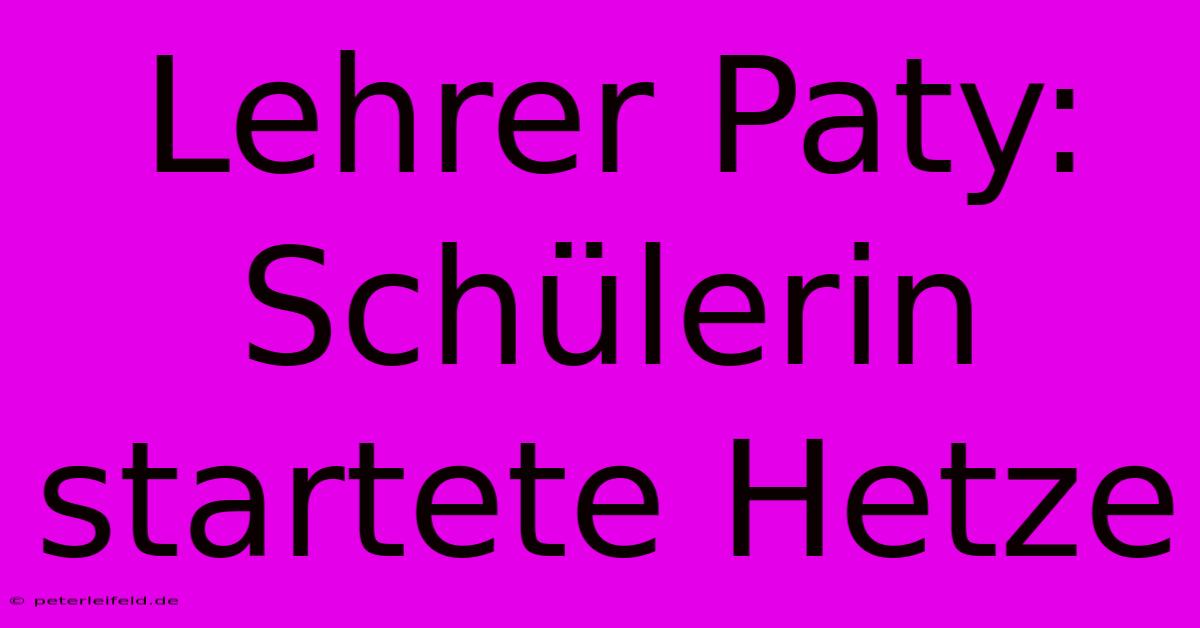Lehrer Paty: Schülerin Startete Hetze

Discover more detailed and exciting information on our website. Click the link below to start your adventure: Visit Best Website Lehrer Paty: Schülerin Startete Hetze. Don't miss out!
Table of Contents
Lehrer Paty: Schülerin startete Hetze – Ein Schock für das gesamte System
Man, what a rollercoaster. When I first heard about the Paty case – the horrific murder of Samuel Paty, a French teacher, because he showed cartoons of Mohammed in class – I was absolutely gutted. It felt like a punch to the gut. Honestly, I couldn't believe it. This wasn't just some isolated incident; it was a brutal attack on freedom of speech and education. And to think it all started with a student launching a hate campaign… it's chilling.
The Role of Social Media in the Tragedy
The thing that really got to me was the role social media played. I mean, I'm no expert, but it seems pretty clear that this whole thing was fueled by online hate. A student, allegedly, started spreading lies and inflammatory messages about Paty. It was a wildfire, spreading misinformation and anger like crazy. This wasn't just some random kid; this was someone actively participating in a digital lynch mob. It’s terrifying to think how easily things can escalate online.
I remember seeing the news reports, the images… it was overwhelming. I felt a wave of anger and sadness wash over me. It hit hard because I've spent years working with young people. I’ve seen firsthand the power — both good and bad — of social media. I've seen kids build incredible communities online. But I've also witnessed the destructive side – the bullying, the hate speech, the manipulation. This case was the ultimate example of the latter.
Preventing Future Tragedies: Practical Steps We Can Take
So, what can we do to prevent something like this from happening again? It’s a huge question, and honestly, I don’t have all the answers. But here are a few thoughts, based on my experience and what I’ve learned:
1. Media Literacy is Key: We absolutely need to teach kids – and adults, for that matter – about critical thinking and media literacy. It's not enough to just let them loose on the internet. We need to equip them with the skills to identify misinformation, propaganda, and hate speech. Think of it like learning to swim – you can’t just throw kids in the water and expect them to figure it out. We need to give them the tools to navigate the online world safely and responsibly.
2. Strengthening Online Safety Protocols: Schools and social media platforms need to work together to improve online safety measures. This means better monitoring, clearer guidelines, and stricter enforcement of rules against hate speech and harassment. It’s a complex issue, but we can’t afford to ignore it. It’s not about censorship, it’s about creating a safer environment. This might involve more parental controls, better reporting mechanisms, and improved AI detection of harmful content.
3. Promoting Empathy and Understanding: We need to foster empathy and understanding in our schools and communities. This means teaching kids about different cultures, religions, and perspectives. It's about creating a classroom environment where everyone feels safe and respected, regardless of their beliefs. This isn't just about tolerance; it's about actively celebrating diversity.
4. Holding Individuals Accountable: Individuals who spread hate and misinformation online need to be held accountable for their actions. This might involve legal consequences, but also social consequences. We need to create a culture where hate speech is not tolerated and those who engage in it face real repercussions. This is a delicate balance – free speech is paramount, but that doesn’t mean we should tolerate hate speech.
This whole situation with Paty was a wake-up call. It highlighted the dangers of unchecked online hate and the urgent need for improved media literacy and online safety measures. We need to work together – parents, educators, policymakers, and tech companies – to create a safer and more respectful online world for everyone. It’s a massive task, but it's one we simply can't afford to ignore. We owe it to Samuel Paty, and to future generations.

Thank you for visiting our website wich cover about Lehrer Paty: Schülerin Startete Hetze. We hope the information provided has been useful to you. Feel free to contact us if you have any questions or need further assistance. See you next time and dont miss to bookmark.
Featured Posts
-
Gottschalks Spruch Maite Kelly Findet Inakzeptabel
Nov 27, 2024
-
Champions League 3 3 City Patzt
Nov 27, 2024
-
Camora Konzert Schleyerhalle Bericht
Nov 27, 2024
-
Deutlicher Sieg Leverkusen Gegen Salzburg
Nov 27, 2024
-
3 0 Fuehrung Man City Patzt Gegen Feyenoord
Nov 27, 2024
